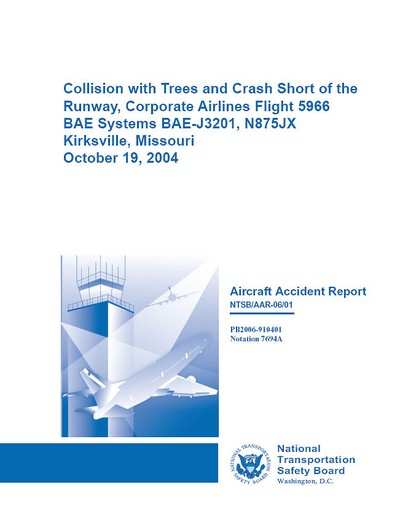Wed, Feb 22, 2006
Collision with Trees
and Crash Short of the Runway, Corporate Airlines Flight 5966
BAE Systems BAE-J3201, N875JX
Kirksville, Missouri
October 19, 2004
NTSB Number AAR-06/01
NTIS Number PB2006-910401
Executive Summary: On October 19, 2004, about
1937 central daylight time, Corporate Airlines (doing business as
American Connection) flight 5966, a BAE Systems BAE-J3201, N875JX,
struck trees on final approach and crashed short of runway 36 at
the Kirksville Regional Airport (IRK), Kirksville, Missouri. The
flight was operating under the provisions of 14 Code of Federal
Regulations Part 121 as a scheduled passenger flight from
Lambert-St. Louis International Airport, in St. Louis, Missouri, to
IRK. The captain, first officer, and 11 of the 13 passengers were
fatally injured, and 2 passengers received serious injuries. The
airplane was destroyed by impact and a postimpact fire. Night
instrument meteorological conditions (IMC) prevailed at the time of
the accident, and the flight operated on an instrument flight rules
flight plan.
The National Transportation Safety Board determines that the
probable cause of the accident was the pilots’ failure to
follow established procedures and properly conduct a nonprecision
instrument approach at night in IMC, including their descent below
the minimum descent altitude (MDA) before required visual cues were
available (which continued unmoderated until the airplane struck
the trees) and their failure to adhere to the established division
of duties between the flying and nonflying (monitoring) pilot.
Contributing to the accident was the pilots’ failure to
make standard callouts and the current Federal Aviation Regulations
that allow pilots to descend below the MDA into a region in which
safe obstacle clearance is not assured based upon seeing only the
airport approach lights. The pilots’ unprofessional behavior
during the flight and their fatigue likely contributed to their
degraded performance.

The safety issues in this report focus on operational and human
factors issues, including the pilots’ professionalism and
sterile cockpit procedures, nonprecision instrument approach
procedures, flight and duty time regulations, fatigue, and flight
data/image recorder requirements.
More News
Aero Linx: Model Aeronautical Association of Australia MAAA clubs are about fun flying, camaraderie and community. For over 75 years, the MAAA has been Australia’s largest fl>[...]
Touchdown Zone Lighting Two rows of transverse light bars located symmetrically about the runway centerline normally at 100 foot intervals. The basic system extends 3,000 feet alon>[...]
“Discovery and innovation are central to our mission at Virgin Galactic. We’re excited to build on our successful record of facilitating scientific experiments in subor>[...]
How To Get A Story On Aero-TV News/Feature Programming How do I submit a story idea or lead to Aero-TV? If you would like to submit a story idea or lead, please contact Jim Campbel>[...]
Student Pilot Reported That During Rotation, “All Of A Sudden The Back Of The Plane Kicked To The Right..." Analysis: The student pilot reported that during rotation, “>[...]
 ANN's Daily Aero-Linx (05.02.24)
ANN's Daily Aero-Linx (05.02.24) ANN's Daily Aero-Term (05.02.24): Touchdown Zone Lighting
ANN's Daily Aero-Term (05.02.24): Touchdown Zone Lighting Aero-News: Quote of the Day (05.02.24)
Aero-News: Quote of the Day (05.02.24) ANN FAQ: Contributing To Aero-TV
ANN FAQ: Contributing To Aero-TV NTSB Final Report: Cirrus Design Corp SR20
NTSB Final Report: Cirrus Design Corp SR20



